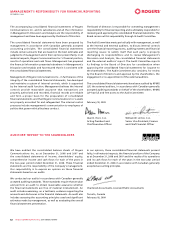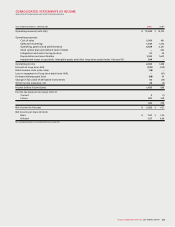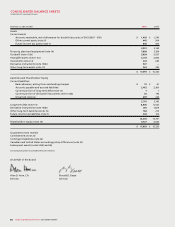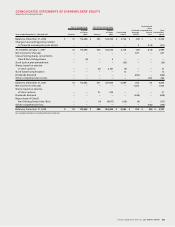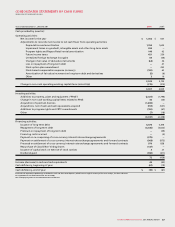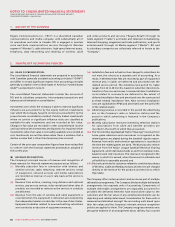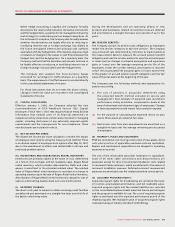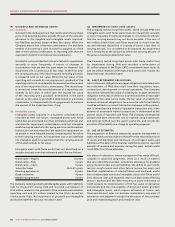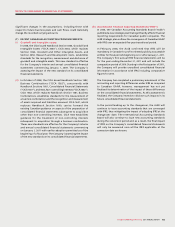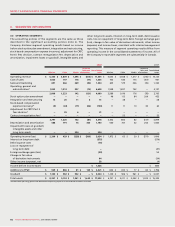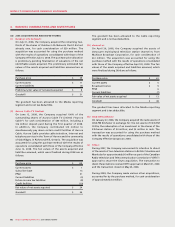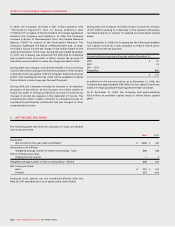Rogers 2008 Annual Report Download - page 95
Download and view the complete annual report
Please find page 95 of the 2008 Rogers annual report below. You can navigate through the pages in the report by either clicking on the pages listed below, or by using the keyword search tool below to find specific information within the annual report.
ROGERS COMMUNICATIONS INC. 2008 ANNUAL REPORT 91
NOTES TO CONSOLIDATED FINANCIAL STATEMENTS
During the development and pre-operating phases of new
products and businesses, related incremental costs are deferred
and amortized on a straight-line basis over periods of up to five
years.
(M) PENSION BENEFITS:
The Company accrues its pension plan obligations as employees
render the services necessary to earn the pension. The Company
uses a discount rate determined by reference to market yields at
the measurement dates to measure the accrued pension benefit
obligation and uses the corridor method to amortize actuarial gains
or losses (such as changes in actuarial assumptions and experience
gains or losses) over the average remaining service life of the
employees. Under the corridor method, amortization is recorded
only if the accumulated net actuarial gains or losses exceed 10%
of the greater of accrued pension benefit obligation and the fair
value of the plan assets at the beginning of the year.
The Company uses the following methods and assumptions for
pension accounting:
(i) The cost of pensions is actuarially determined using
the projected benefit method prorated on service and
management’s best estimate of expected plan investment
performance, salary escalation, compensation levels at the
time of retirement and retirement ages of employees. Changes
in these assumptions would impact future pension expense.
(ii) For the purpose of calculating the expected return on plan
assets, those assets are valued at fair value.
(iii) Past service costs from plan amendments are amortized on a
straight-line basis over the average remaining service period
of employees.
(N) PROPERTY, PLANT AND EQUIPMENT:
PP&E are recorded at cost. During construction of new assets, direct
costs plus a portion of applicable overhead costs are capitalized.
Repairs and maintenance expenditures are charged to operating
expenses as incurred.
The cost of the initial cable subscriber installation is capitalized.
Costs of all other cable connections and disconnections are
expensed, except for direct incremental installation costs related
to reconnect Cable customers, which are deferred to the extent of
reconnect installation revenues. Deferred reconnect revenues and
expenses are amortized over the related estimated service period.
(O) ACQUIRED PROGRAM RIGHTS:
Acquired program rights for broadcasting are carried at the lower
of cost less accumulated amortization, and net realizable value.
Acquired program rights and the related liabilities are recorded
on the consolidated balance sheets when the licence period begins
and the program is available for use. The cost of acquired program
rights is amortized over the expected performance period of the
related programs. Net realizable value of acquired program rights
is assessed using an industry standard methodology.
When hedge accounting is applied, the Company formally
documents the relationship between derivative instruments
and the hedged items, as well as its risk management objective
and strategy for undertaking various hedge transactions. At
the instrument’s inception, the Company also formally assesses
whether the derivatives are highly effective at reducing or
modifying interest rate or foreign exchange risk related to
the future anticipated interest and principal cash outflows
associated with the hedged item. Effectiveness requires a high
correlation of changes in fair values or cash flows between the
hedged item and the hedging item. On a quarterly basis, the
Company confirms that the derivative instruments continue to
be highly effective at reducing or modifying interest rate or
foreign exchange risk associated with the hedged items.
The Company also assesses the Cross-Currency Swaps
accounted for as hedges for ineffectiveness on a quarterly
basis. The measurement of ineffectiveness is recorded directly
in the consolidated statements of income.
For those instruments that do not meet the above criteria,
changes in their fair value are recorded in the consolidated
statements of income.
(I) CAPITAL DISCLOSURES:
Effective January 1, 2008, the Company adopted the new
recommendations of CICA Handbook Section 1535, Capital
Disclosures (“CICA 1535”). CICA 1535 requires that an entity disclose
information that enables users of its financial statements to
evaluate an entity’s objectives, policies and processes for managing
capital, including disclosures of any externally imposed capital
requirements and the consequences for non-compliance. These
new disclosures are included in note 21.
(J) NET INCOME PER SHARE:
The diluted net income per share calculation considers the impact
of employee stock options using the treasury stock method. There
is no dilutive impact of employee stock options after May 28, 2007,
due to the amendment to attach cash settled SARs to all new and
previously granted options.
(K) INVENTORIES AND ROGERS RETAIL RENTAL INVENTORY:
Inventories are primarily valued at the lower of cost, determined
on a first-in, first-out basis, and net realizable value. Rogers Retail
rental inventory, which includes videocassettes, DVDs and video
games, is amortized to its estimated residual value. The residual
value of Rogers Retail rental inventory is recorded as a charge to
operating expense upon the sale of Rogers Retail rental inventory.
Amortization of Rogers Retail rental inventory is charged to cost of
sales on a diminishing-balance basis over a six-month period.
(L) DEFERRED CHARGES:
The direct costs paid to lenders to obtain revolving credit facilities
are deferred and amortized on a straight-line basis over the life of
the debt to which they relate.



